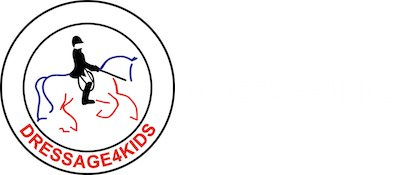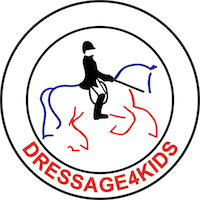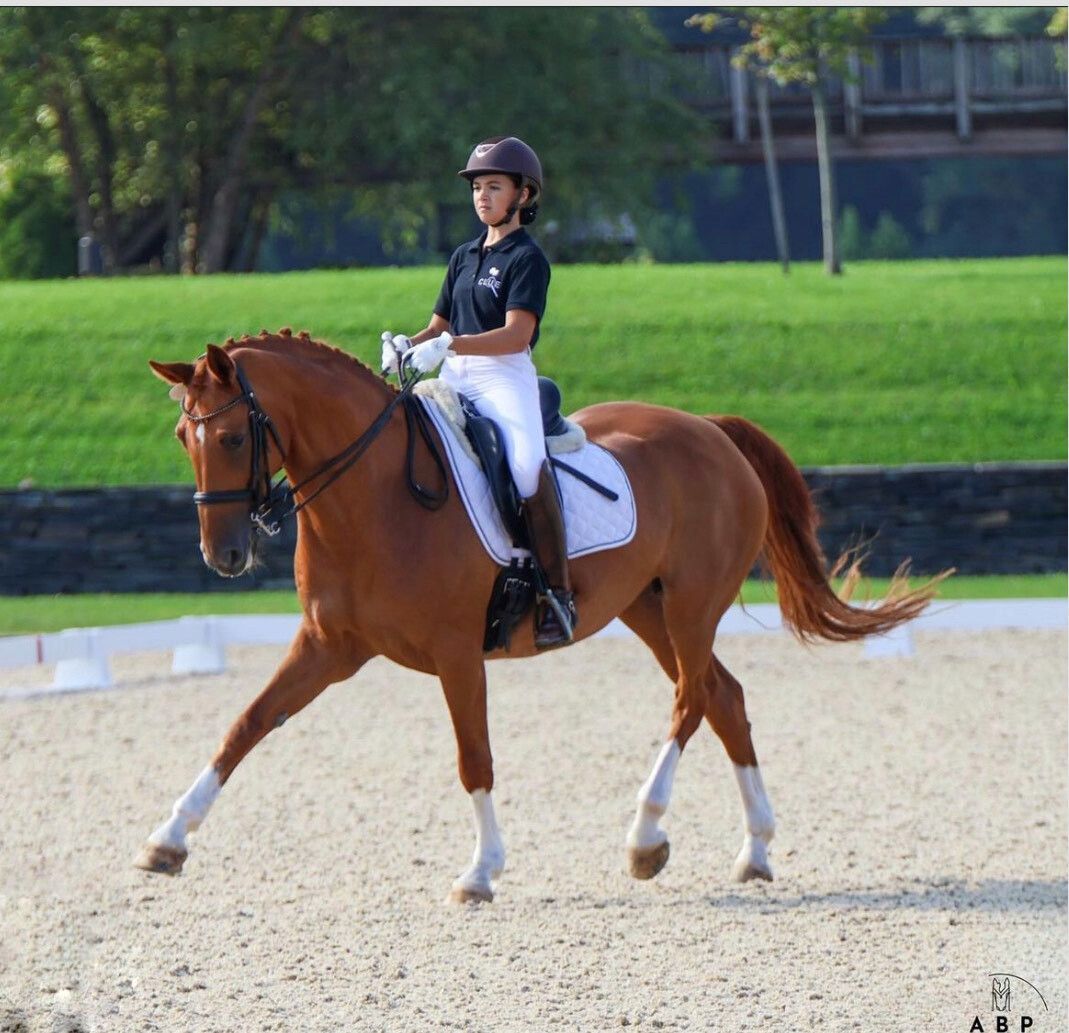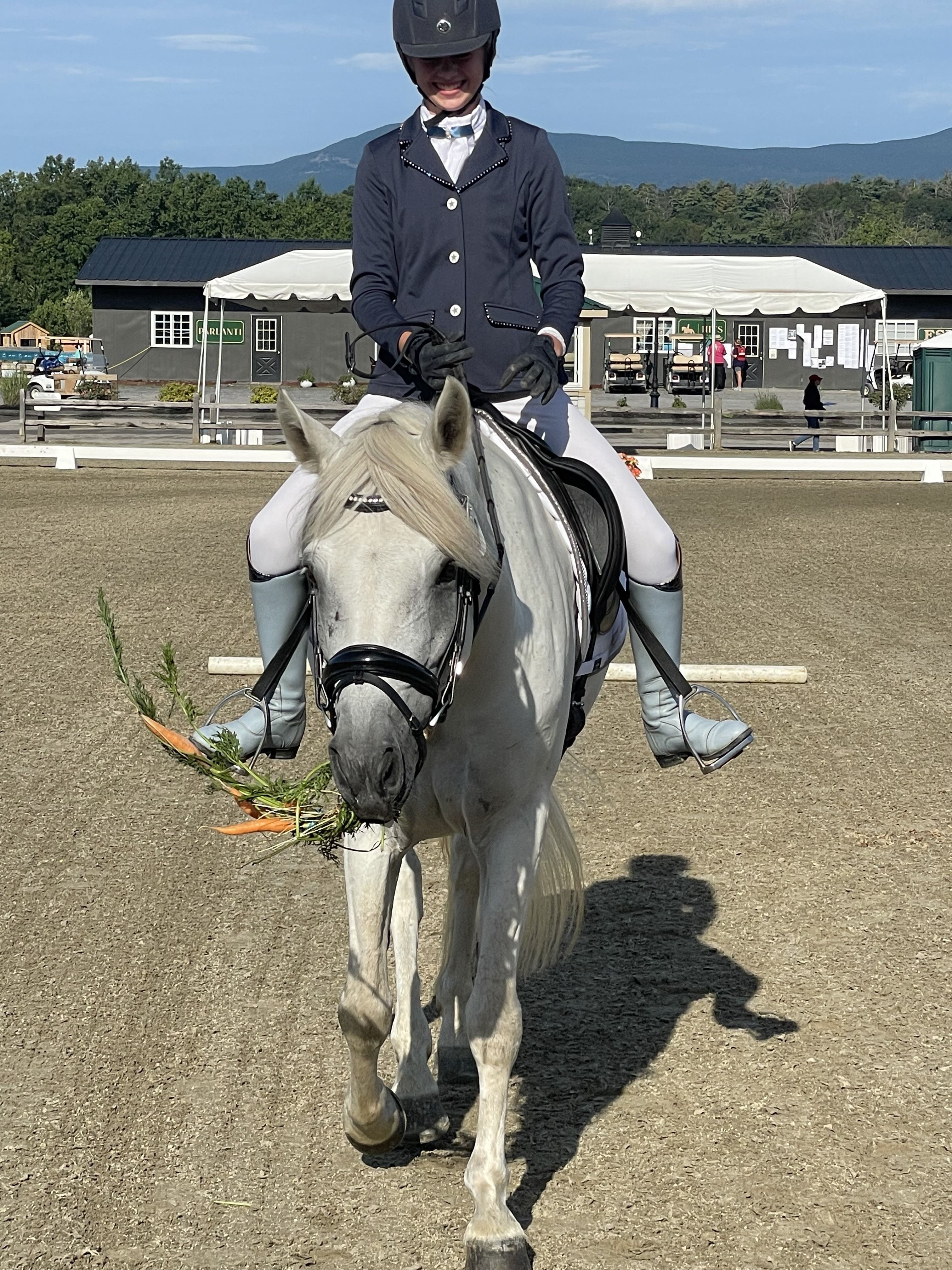The Clovis Horsemanship Award is given in memory of Clovis, a larger-than-life Oldenburg gelding who triumphed over multiple health challenges to compete successfully at the FEI levels into his mid-20s. His success was a testament to careful nutrition, exceptional veterinary care, and dedicated horsemanship.
The Clovis Horsemanship Award honors competitors at the Dressage4Kids Youth Dressage Festival who demonstrate similar dedication to the care of their equine partners. To be eligible for this award, competitors must submit a written document explaining the horse's health issues, along with their medical, nutritional, and psychological needs and how the rider helps care for the horse mentally and physically for the horse to stay happy in its work. The winner will be the highest scoring rider (Division Score) of those who qualify. This award is sponsored by Triple Crown, Cherry Ridge Dressage, Spa Equine Sports Medicine, and Friends of Clovis.
Read some of the essays submitted here below:
-
Clovis Award Essay-Gianna Calabro
My name is Gianna Calabro and I will be competing on my horse Carlchen. Carl is an 15 year old Oldenburg gelding. My mom and I got Carl in 2021 and he quickly won us over with his goofy personality and exceptional work ethic. Being a grey horse we were not surprised to find a few melanomas, but we did not expect to find a rather large one in his inguinal areas. Carl has undergone several surgeries to remove the larger masses for him to move comfortably including a complicated stay at Tuft Vet hospital. He is currently on the Oncept melanoma vaccine that helps keep the masses from growing too fast.
Carl made his D4K debut in 2023 with one of my older “barn sisters”. They had a great show and even won a few of the perpetual awards but two days after coming home from Saugerties, we think he injured himself in turn out. Our local vets couldn’t figure out where it was coming from so we took him back to Tufts Veterinary hospital for a lameness work up. They found he had injured his right distal seasmoidial ligament and the treatment was 2-4 months of stall rest.
On stall rest he was very agitated and needed daily meds to keep calm, but the stress was too much and he coliced the second week of stall rest and needed to go back to Tufts and was hospitalized for 3-days. Thankfully no surgery was needed to fix the displaced colon and he was released with a higher dose of calming medications.
Throughout the winter he stayed on stall rest with twice daily hand walks, we discovered that the longer he was on stall rest the worse he walked (like stringhalt). Every six weeks we would bring him back to Tufts to check on the injured leg, it became clearer that he was becoming worse overall with his hind end movement. Neurology did an exam and determined that he could have wobblers syndrome. They did neck x-rays and discovered he has severe osteoarthritis in his neck that could be causing some of the neurological issues. We did steroid injections in his neck and started his rehab.
During stall rest we were constantly looking for new enrichment ideas and keep him mentally happy. We made hanging treat balls made of apples and carrots, ground feeders that he kicked around, hand walking to see friends, we make licky mats with his favorite mashed up treats, we had boxes of dog toys that he could nose through to find hay pellets. We looked for anything and everything to make life just a little bit more interesting for Carl.
The rehab of his leg and his neck was very slow and strictly scheduled. Each week we were able to walk him 5 more minutes on the lunge or in hand. He has specific neck stretches for the arthritis and in hand pole exercises to help with his proprioception and his funny walk. Eventually we could tack walk him and lunge at the trot. That turned into walk and trot under saddle. By the fall of 2024 he was finally cleared to resume normal work (but no jumping). We needed to build back all the muscle he lost, so his diet was monitored very closely. We added a higher protein supplement to help build muscle, he got 8,ooo units of Vitamin E daily for neurological support, a supplement to support ligaments/tendons and another supplement for his gastro health.
Almost two years later, Carl is sound and happy. He still has his 6 months visits to Tufts for his Oncept (melanoma vaccine) and his neck injections, he still gets Vitamin E and Adequan injections for arthritis. His neurological symptoms are gone, and the gait abnormality only shows up when walking in hand or when he is nervous or excited under saddle. We are very lucky that we didn’t need to retire him completely and I feel grateful to have the opportunity to finally participate in D4k with Carlchen. -
Hi, my name is Selina Kozlowski and my horse's name is Georgia. She is a 11yo Friesian cross mare. I got Georgia about a year and a half ago as a project. She was very green walk/trot unsaddle, did not have a canter undersaddle, and had a bucking issue. The vet floated her teeth and did not think she had ever had her teeth done and she was 10 years old. She had mutliple ulcers throughout her month. Her training was progressing well after we sorted out her teeth, until last July, when she got Potamic Horse Fever and had an impaction colic due to the virus. Unfortunately, surgery was not an option for us. Luckily, our amazing vet agreed to put an IV Catheter in so we could give her fluids day and night at home and pray for a recovery. Along with the fluids, she was getting several medications multiple times a day. A couple days went by and no luck. It was looking like euthanisa was the only option left. Later that day, she miraculously passed some fecal matter and later that night, passed the impaction. But, we weren't out of the woods yet. All of the medications negatively affected her gut health and caused ulcers so severely that she was showing colic symotoms from the pain. So now, she was getting other medications and supplements to help restore gut health. It took several months, but she eventually fully recovered and has been back in full work for about 7 months now. I am still very careful with her stress level, as she gets stressed very easily. Georgia still gets her special medications any time we are traveling or showing to prevent ulcers. She gets a daily gut health supplement daily. To prepare for the Festival, we went to several local shows over the summer. Sometimes we would show, sometime I would just take her and hand graze her. The goal was to get her comfortable traveling and going off property. It was a very long road to get where we are now, but I am happy to say she has been doing very well and progressing in her training. I am excited to see how she does at the Festival.
-
The Clovis Memorial Award YDF 2025
Bella Perkins & Royal RhapsodyMy horse Rhapsody suffers from Inflammatory Airway Disease, or Equine Asthma, which is a chronic respiratory condition characterized by inflammation and narrowing of the small airways in the lungs. It's primarily triggered by inhaled allergens, such as dust, mold, and pollen found in hay, straw, and bedding. When I first got him in 2021, we were aware that he had mild asthma, but the only management he needed at the time was plenty of airflow in his stall and lots of turnout. Over that first winter, he started having upper respiratory infections and he would cough and wheeze when trotting and cantering. After being diagnosed with IAD, we began soaking all of his hay to remove the allergens that were triggering him. This worked like magic for him and cut down on his problems by 90%. He also does best when he’s able to be out on grass, but in Upstate NY, that’s only possible for ½ of the year. He still has rare days where he struggles to breathe during exercise, mostly in extreme heat or cold, or when the pollen count is high. On those days, I either don’t work him, or just stick to walk work. If it lasts multiple days, we give him dexamethasone to reduce the inflammation, but we have not had to do that in quite a long time.
Rhapsody also had an osteochondroma, which is a benign bone tumor, typically found near growth plates. They are cartilage-capped bony growths that can cause lameness and swelling, particularly in young, rapidly growing horses. Rhapsody’s was quite unique, because it was on the right side of his jaw. It started growing when he was around 2 years old. His previous owner never had it surgically removed because it didn’t seem to bother him. That was also my way of thinking for the first few years I had him. One vet that looked at it also thought that it could grow back bigger if we removed it. Last summer, we noticed it seemed to be growing. It got to the point that when he would roll, he hit it on the ground and had an open wound on the end of it. It wouldn’t heal quickly enough before the next time he would roll, so it kept getting worse. Aside from the risk of infection, I couldn’t ride him at this time because the rein would rub on it. We decided it was finally time to surgically remove it. Dr. Mike Ross at Pine Bush Equine did a fantastic job with the surgery and it was the largest osteochondroma he had seen. He believed that it would not grow back because the growth was from the cap on the end of it, not the base. Now, you can barely tell anything was there unless you’re very close up. Rhapsody seems much happier and more comfortable in many aspects of his life! It’s been over 8 months since the surgery, and it shows no indications of growing back.
-
Clovis Horsemanship Award: Kissing Spine & Spondylosis
by Madeline Fasse
My horse Filia is challenged with Kissing spine and Spondylosis. It has affected her in many ways and how we have to care for her. Kissing spine, also known as Overriding Dorsal Spinous Processes (ORDSP). This occurs when two or more bony projections at the top of the vertebrae (dorsal spinous processes) touch or overlap. Some horses with mild kissing spine show no signs of pain but others will show lameness, behavior changes, bucking. Vets will diagnose Kissing spine with x-rays or an MRI. Filias Kissing spine has progressed to Spondylosis because of the intensity of her kissing spine. Spondylosis is a condition that affects the vertebral bodies and discs in the horse's spine. It is mainly found in between the 11th and 13th thoracic vertebrae. The spine may lose its flexibility due to the bone changes.
The care for Filia is very complex. She has to get body work, supplements, shots and PEMF therapy. Going deeper into body work; she gets sports massage and graston fascia release every week. If we dont keep up on this there would be fascia buildup and stiffness. For the supplement she gets magnesium to relax the muscles by pushing calcium back out of the cell's contraction. Filia gets Osphos every 6 months and Adequan every 6 months. She also uses the Beamer. The Beamer is a form of PEMF therapy. All of this helps her be the happy spoiled horse that she deserves to be.
-
Clovis Horsemanship Award Essay
By: Abigail Parent
My horse's name is Benny. He is a 6 year old Connemara and I have owned him since he was a yearling. What Benny lacks in conformation of his front legs, he makes up for with his big heart! There are several key management strategies that we do to keep him happy and comfortable in his job. We x-rayed his feet as a 3 year old before he was backed and learned he had cysts, arthritis and sidebone in both front feet. My farrier uses pour in pads on his front feet. This helps increase frog to ground contact, improves blood flow, and provides cushioning. We also make sure to keep his shoeing cycle to every 5 weeks to help maintain his hoof angles. This past spring our vet injected Benny's front feet with Arthomed because he was showing increased discomfort. Arthomed is a hydrogel that does not harm the joint like other injectables can. This is especially important because he is only 6. This drug used to be just used as a final option but now it is being used earlier as a method to prevent joint damage and great results have been seen. (Which I have seen as well) Some other things we do in everyday life to help him is use fly boots in the summer to help lessen concussion on his feet from stomping. I am also very particular with the types of footing I ride him on and never ride him on hard ground. He gets 24/7 turn out with an in and out to maximize movement. Since Benny has experienced pain at times in his life he is very prone to stomach issues. WIth Benny it's really important to be very observant of changes in behavior as he does not alway show how much pain he is in. Management of his nutritional needs is also very important to keeping him comfortable. I am so lucky to have such a great farrier and vet team and a supportive family who will give the world for him. I believe that learning good horsemanship skills is fundamental to owning horses and developing as a rider.
-
The Clovis Memorial Award
Bella Perkins & Wow Factor
The mare I am bringing to YDF this year, Wow Factor (AKA “Wonder”), has been through a lot in her short 9 years on earth. Although she has only been with her current owner and in training with us for a year, we work daily to keep her comfortable and thriving. When Wonder was just 5 years old, she had severe laminitis in her front feet and had a double tenotomy (cutting the deep digital flexor tendons to stop some of the force on the coffin bones). A few weeks later, while still healing, it was found that she was not able to breathe through her nose. When an endoscopy and X-Rays were done, there was a mass seen that was blocking her nasal passage. She had a tracheostomy to help her breathe and a CT was taken. The CT showed a “large soft tissue right nasal mass, with caudoventral extension into the nasopharynx and a secondary sinusitis.” In basic terms, she had what has been described to us as a “dumbbell” sized tumor in her nasal passage and extending into her throat, and an infection in her sinuses. Exploratory surgery was the only option to potentially save her life. The surgery was a success, and they were able to remove what was, thankfully, a noncancerous polyp. She then had a long recovery from both the laminitis and the extensive surgery.
Wonder entered our lives almost 3 years after all this. Even with all she has been through, she is the sweetest mare with a great work ethic. I would say that the biggest hurdle we have been through with her is the maintenance of her front feet. Due to the tenotomy, she tends to drop through her heels, making her toes appear long and her heels underrun. A few months ago, her farrier switched her to heart bar shoes to relieve her heels by spreading the weight more evenly. The shoes have significantly improved her hooves. Her feet are done every 4 weeks and I’m sure this is something we will have to stay on top of her entire life to keep her as comfortable as possible.
Because of her laminitis and metabolic issues, we are very careful with Wonder’s diet. Last year, we limited her grass consumption during the summer with a grazing muzzle. She seemed to find the muzzle quite frustrating! This year we have kept her off grass and she has hay 24/7. She is also on a low sugar and low starch grain. Her weight has been great and when we tested her insulin and glucose levels recently, they were perfect.
Wonder is understandably a little sensitive around her face due to the extensive surgery and months of healing afterwards. She is much better than we expected, as long as we are gentle when we touch her face and don’t tighten her noseband or flash too much. Under saddle, she tends to toss her head a lot, which we assume is a kind of defense mechanism. This is not something we can force her to stop doing, especially since she is a feisty chestnut mare at times! Over the last year, we’ve been trying get to the root of the problem without breaking her trust in us and ruining her work ethic. We’ve found that she’s much better when she’s ridden forward from the hind end and kept on the aids. Her early career was as a hunter/jumper, so she’s not very used to the rider influencing her as much as we do in dressage. It’s taken awhile, but she has gotten much steadier in the connection and seems more content in work than ever!




